It's strange how we seem to take so many things for granted, and let so much good local history slip right away from us. However
I'll try to recoup from memory some things I remember, particularly from 1916 on to its demise including a little historical background.
The Railroad was really two organizations. The first owned by a group of local stockholders from 1868-1896. When they defaulted
another company was organized in 1897 with Mr. Vincent Sebold as Vice President, and Miss Louise Sebold as Secretary.
The Sisters of Charity owned three
fourths of the capital Stock, and the other one fourth was owned by private ownership. That Company existed from 1897-1939. In 1939-1940 all stocks were
recalled so that final payments could be made and the Emmitsburg Rail road Co. - closed it's doors forever. This Company consisted of 7.3 miles of
privately owned railroad which was in itself a unique venture.
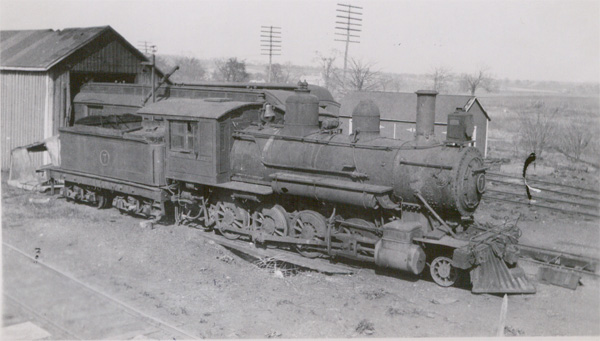
Click on photo for larger version
The railroad line ran from Emmitsburg to Rocky Ridge and carried passengers as well as all kinds of freight, mail and parcel
post. (Map of the route of the Emmitsburg railroad)
The American Express Co. had its office and storage room in the central area of the railroad building. All of the coal used by
St. Joseph's and Mt. St. Mary's as well as that used by the other local residents was brought in by the car load, There were storage bins along the road
in the area of the New St. Joseph's Cemetery.
St. Joseph's had a short railroad line that carried their car loads of coal to the power house. Messers
Harry and J. Brooke Boyle, trading under the name of Boyle Brothers Feed and Farm Supplies, carried a line of feed., fertilizer, coal, farm tools and
machinery. Their warehouse was housed at the northern end of the Railroad building. In those days much of the farm machinery was shipped to the dealers
in crates, and was then assembled for sale.
Farmers shipped milk to the Baltimore market, and it was sent by train to Rocky Ridge, where it was put on the western Md. for
its trip to Baltimore. The milk was put in 5 or 10 gallon cans shipped out in the morning and the clean empty cans were returned in the evening. There
were times in winter when there were snow problems that farmers had to feed the milk to the hogs because they were short of cans and storage tanks were
unheard of.
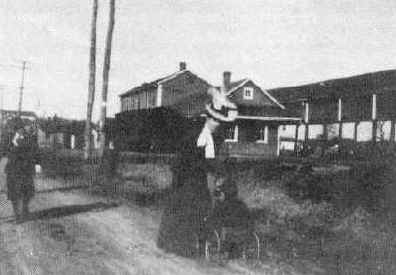 The Railroad Station was directly opposite the present Community Center. It was quite a long building which housed the three
different businesses. The Railroad office at the southern end consisted of the business office and the waiting room. The business office contained a
huge pot bellied stove. You couldn't get too near that because there was a heavy wire grating between the waiting room and the Office.
The Railroad Station was directly opposite the present Community Center. It was quite a long building which housed the three
different businesses. The Railroad office at the southern end consisted of the business office and the waiting room. The business office contained a
huge pot bellied stove. You couldn't get too near that because there was a heavy wire grating between the waiting room and the Office.
With the coming of school consolidation came many changes. A few children had gone to High School by train but by 1916 grade 6
in many rural schools were sent to larger schools and you had to find your own transportation. Aprold's Children were sent to Emmitsburg over the
objection of many parents. But we felt lucky we could go on the train, and our parents paid the bill. $l.95 for a ticket of 30 one way trips that meant
a new ticket for each child every 15 days. Eventually as these rural schools closed the Board of Education used buses for the transportation job. St.
Joseph's had always used the Railroad as their main means of transportation. At holiday time special cars were brought in from the Western Maryland R.R.
to carry large numbers of sisters and students at one time.
The Emmitsburg R. R. had a combination passenger car-baggage car which was used for regular service, but in later years
purchased what was called a Parlor Car. This was real luxury-individual swivel chairs covered in brown velvet. It was a rare treat indeed when we
regular school girls were allowed to ride in the Parlor Car.
St. Joseph's had it's own station at the end of the tree lined Avenue and what is now Route 15. Passenger service was curtailed in 1935.
In the mid-twenties farmers began to enlarge and upgrade their dairy herds. Local cattle dealers such as Ernest Heilholtz,
Robert Gillelan, and George Eyster among others went to Michigan where they purchased purebred Holstein cattle. This was a heavy milk producing breed
and were in great demand by the farmers. Dairying was fast becoming a profitable type of farming, and the Baltimore market was so available. The cattle
were shipped by the Western Md. train to Rocky Ridge, arriving at night. If the Emmitsburg dealers had full car loads they were sent to town on the
Emmitsburg R. R. but Mr. Keilholtz's cattle care were unloaded at Rocky Ridge and driven on foot to Mr. Charles Bollinger's meadow where shortly
thereafter they were sold at a big auction sale, complete with their registered papers.
This was quite an exciting time like a touch of the "Old west" right on our own old dirt road. These cattle had to be moved as
quickly as possible. They had already traveled a long distance in a cramped cattle car, and it was to their best advantage to be moved as rapidly as
possible.
Snow was always a problem with the railroad. Seems as if it snowed more, and winters were longer and colder then. It wasn't
unusual to have times when we'd have seven or eight inches of snow and in the course of a week we'd have seven or eight inches of snow and in the course
of a week we'd have that repeated maybe several times. The snow would pack, freeze and form a hard crust. Strong winds always seemed to accompany these
snow storms, that meant big drifts in the "cut" back of our place. At times such as this every man and boy able to wield a shovel was actively engaged
in shoveling snow. After several of these snows there was no way the "cow catcher" could remove the snow from the tracts. There was only one way that
was by manpower. You couldn't push it off the track since there was no place to push it as the side of the track was already a wall of snow.
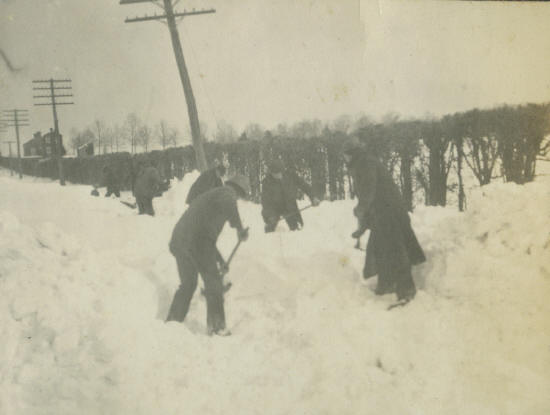
Clearing Emmitsburg Railroad tracks after snow storm of 1916. Houses in background are the guest house for St. Joseph's College and St. Josephs
station on Emmitsburg railroad.
The winter of 1916 was especially snowy one. The train had been snowed in for several days: by the time they'd think they were
out and ready to go gale like winds closed them right back in again. I remember Mr. Neil Gelwicks, the engineer and Mr. Charles Bowers, the fireman had
worked until they were nearly overcome with the cold. They were brought to our house, and my mother helped thaw them out by the kitchen stove, and fed
them a lot of hot broth and coffee, at the same time was preparing meals for other workmen on an almost round the clock basis. These men worked very
hard in the cold, and were hungry. Fortunately we had plenty of food on hand. We had recently butchered and had a side of beef, and a well stocked
cellar of home grown vegetables. In the morning huge stacks of pancakes were consumed. Huge pots of soup were kept warm in case it was needed. The
Sebolds made sandwiches and sent them out to the workers sometimes by the men who were walking out to help with the shoveling.
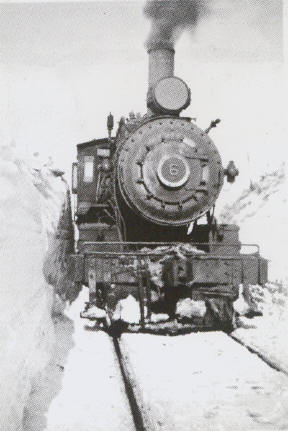 Of course at times like these we had time off from school. The first day we did homework after that it was wash and dry dishes.
You see there was no radio, T.V. etc. in fact we had the only telephone between Rocky Ridge and Motters Station- Miss Nellie Felix was the C. and P.
Exchange Operator who helped keep us informed if we were otherwise cut off from public information.
Of course at times like these we had time off from school. The first day we did homework after that it was wash and dry dishes.
You see there was no radio, T.V. etc. in fact we had the only telephone between Rocky Ridge and Motters Station- Miss Nellie Felix was the C. and P.
Exchange Operator who helped keep us informed if we were otherwise cut off from public information.
Father Hayden often showed movies to the St. Euphemia's students on Friday afternoon. Occasionally he'd invite certain classes
from the Public School to attend a show. One spring day our class was invited. We were so engrossed in the War film, and a short comedy that the time
completely eluded us. However we were only a few minutes late and ran desperately to catch the train. Of course they saw us running, but they kept on
going and no way could we catch up with them.
That wasn't the only reason we needed to catch the train, there was a storm rapidly coming across the
mountain. 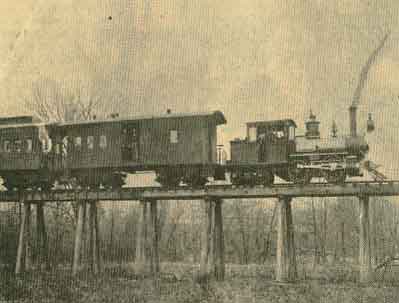 The girls were following the boys and they were following the R. R. tracks which was just a bit shorter than the Old Frederick Rd. route, but
alas! we hadn't thought about the trestle over Tom's Creek that we'd have to cross. Most everyone walked over except a group of we very scared girls who
crossed on our hands and knees. We made it to Dry Bridge before the rain came. The station master called my Mother and she met us at Motters Station,
and took as many of us home as could be packed in a small farm wagon.
The girls were following the boys and they were following the R. R. tracks which was just a bit shorter than the Old Frederick Rd. route, but
alas! we hadn't thought about the trestle over Tom's Creek that we'd have to cross. Most everyone walked over except a group of we very scared girls who
crossed on our hands and knees. We made it to Dry Bridge before the rain came. The station master called my Mother and she met us at Motters Station,
and took as many of us home as could be packed in a small farm wagon.
I hope I don't do an injustice to those faithful souls who were responsible for keeping the train on the track, and running.
Looking back it's hard to tell just what position or title some of these folks held. Seems they were always helping one another,
however these to the best of my knowledge are correct:
- James Boyle, Ticket Agent- Station Manager
- "Bill" Zurgable- American Express
- Ray Dukehart- American Express
- William Morrison - Baggage Master
- Pius Felix - Conductor
- Neil Gelwicks - Engineer
- Charles Bowers - Fireman
- Earl Sheeley - Engineer
- Earl Green - (?) Graham Engineer- Fireman Mechanic
- Charles Wantz Track Man
- Ed. Liday Track Man
- Ross Wood Track Man
- Guy Baker Engineer, Fireman, Mechanic where ever needed
- Harry Wantz Engineer, Fireman, Mechanic where ever needed
- Guy Baker - American Express
- Leslie Fox - Trouble Shooter - filled in almost all positions as needed.
For those of us who grew up with the railroad it was hard to realize that it's time was over. Time marches on. Progress
could not be repressed as other means of transportation replaced our little old #6. An old era had passed and from it's embers a new one was born.
To learn more about the Emmitsburg Railroad we suggest you read the following: